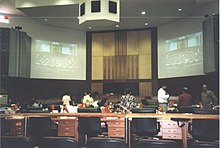National Parliament (East Timor): Difference between revisions
Svyatoslav (talk | contribs) m Voting system change |
|||
| Line 24: | Line 24: | ||
<br>''Aliança Democratica'' ([[Association of Timorese Heroes|KOTA]]–[[People's Party of Timor|PPT]]) (2) |
<br>''Aliança Democratica'' ([[Association of Timorese Heroes|KOTA]]–[[People's Party of Timor|PPT]]) (2) |
||
<br>[[National Unity of Timorese Resistance|UNDeRTim]] (2) |
<br>[[National Unity of Timorese Resistance|UNDeRTim]] (2) |
||
| voting_system1 = |
| voting_system1 = [[Party-list proportional representation]] |
||
| last_election1 = [[East Timorese parliamentary election, 2007|June 30, 2007]] |
| last_election1 = [[East Timorese parliamentary election, 2007|June 30, 2007]] |
||
| session_room = Gouverneurspalast_klein.jpg |
| session_room = Gouverneurspalast_klein.jpg |
||
| Line 34: | Line 34: | ||
The '''National Parliament of East Timor''' ({{lang-tet|Parlamentu Nasionál}}, {{lang-pt|Parlamento Nacional de Timor-Leste}}) is the [[unicameral parliament|unicameral]] national legislature in [[East Timor]]. It was created in [[2001]] as the Constituent Assembly while the country was still under the supervision of the [[United Nations]], but renamed itself to the National Parliament with the attaining of national independence on May 20, 2002. |
The '''National Parliament of East Timor''' ({{lang-tet|Parlamentu Nasionál}}, {{lang-pt|Parlamento Nacional de Timor-Leste}}) is the [[unicameral parliament|unicameral]] national legislature in [[East Timor]]. It was created in [[2001]] as the Constituent Assembly while the country was still under the supervision of the [[United Nations]], but renamed itself to the National Parliament with the attaining of national independence on May 20, 2002. |
||
The number of members of the parliament may range between 52 and 65; it started with 88 members, due to the Constituent Assembly's decision to reform as the National Parliament rather than holding new elections. All members serve five-year terms. Members are elected by a |
The number of members of the parliament may range between 52 and 65; it started with 88 members, due to the Constituent Assembly's decision to reform as the National Parliament rather than holding new elections. All members serve five-year terms. Members are elected by a [[party-list proportional representation|party-list]] system.<ref>Constitution of the Democratic Republic of Timor-Leste</ref> The parliament sits in the National Parliament Building in the capital, [[Dili]], which was specially refurbished with AUD 1.8 million of [[Australia]]n aid assistance in the leadup to independence. |
||
As with many other nations, the party most able to gain a working majority in the parliament forms a government. The members of parliament subsequently elect the head of government, the [[Prime Minister of East Timor|Prime Minister]], who is currently [[Xanana Gusmão]]. Legislation in some areas may be vetoed by the directly elected head of state, the [[President of East Timor|President]], though this is largely a ceremonial role. |
As with many other nations, the party most able to gain a working majority in the parliament forms a government. The members of parliament subsequently elect the head of government, the [[Prime Minister of East Timor|Prime Minister]], who is currently [[Xanana Gusmão]]. Legislation in some areas may be vetoed by the directly elected head of state, the [[President of East Timor|President]], though this is largely a ceremonial role. |
||
| Line 49: | Line 49: | ||
==See also== |
==See also== |
||
*[[Members of the National Parliament of East Timor, 2001-2006]] |
*[[Members of the National Parliament of East Timor, 2001-2006]] |
||
==References== |
|||
<references /> |
|||
==External links== |
==External links== |
||
Revision as of 20:42, 11 July 2012
National Parliament of East Timor | |
|---|---|
 | |
| Type | |
| Type | |
| Leadership | |
President of the National Parliament | |
| Structure | |
| Seats | 65 MPs |
 | |
Political groups | FReTiLIn (21)
UNDeRTim (2) |
Length of term | 5 years |
| Authority | Title III, Part III, Constitution of East Timor |
| Elections | |
| Party-list proportional representation | |
Last election | June 30, 2007 |
| Meeting place | |
 | |
| National Parliament Building, Dili | |

 |
|---|
| Constitution |
|
|
The National Parliament of East Timor (Template:Lang-tet, Template:Lang-pt) is the unicameral national legislature in East Timor. It was created in 2001 as the Constituent Assembly while the country was still under the supervision of the United Nations, but renamed itself to the National Parliament with the attaining of national independence on May 20, 2002.
The number of members of the parliament may range between 52 and 65; it started with 88 members, due to the Constituent Assembly's decision to reform as the National Parliament rather than holding new elections. All members serve five-year terms. Members are elected by a party-list system.[1] The parliament sits in the National Parliament Building in the capital, Dili, which was specially refurbished with AUD 1.8 million of Australian aid assistance in the leadup to independence.
As with many other nations, the party most able to gain a working majority in the parliament forms a government. The members of parliament subsequently elect the head of government, the Prime Minister, who is currently Xanana Gusmão. Legislation in some areas may be vetoed by the directly elected head of state, the President, though this is largely a ceremonial role.
There is universal franchise for all citizens over the age of 17, although voting is not compulsory.
Presidents of the National Parliament of East Timor
- Francisco Guterres (20 May 2002–8 August 2007)
- Fernando de Araújo (8 August 2007–Present)
Latest election
Template:East Timorese parliamentary election, 2007
See also
References
- ^ Constitution of the Democratic Republic of Timor-Leste
